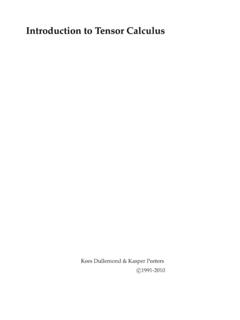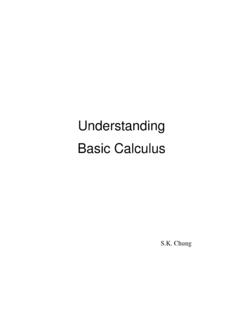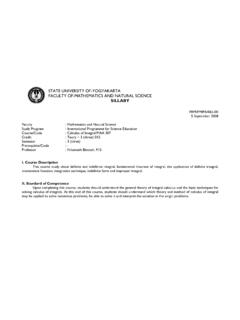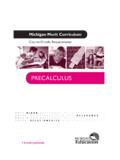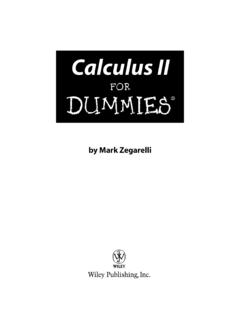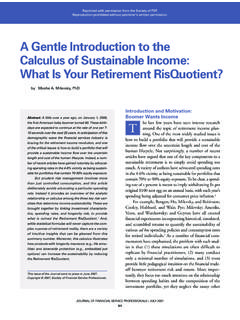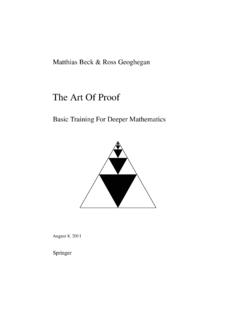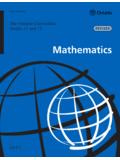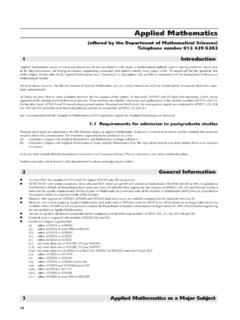Transcription of Kees Dullemond & Kasper Peeters - uni-heidelberg.de
1 Introduction to Tensor CalculusKees Dullemond & Kasper Peetersc 1991-2010 This booklet contains an explanation about tensor calculusfor students of physicsand engineering with a basic knowledge of linear algebra. The focus lies mainly onacquiring an understanding of the principles and ideas underlying the concept of tensor . We have not pursued mathematical strictness and pureness, but insteademphasise practical use (for a more mathematically pure resum e, please see the bib-liography). Although tensors are applied in a very broad range of physics and math-ematics, this booklet focuses on the application in specialand general are indebted to all people who read earlier versions of this manuscript and gaveuseful comments, in particular G. B auerle (University of Amsterdam) and C. Dulle-mond Sr. (University of Nijmegen).The original version of this booklet, in Dutch, appeared on October 28th, 1991.
2 Amajor update followed on September 26th, 1995. This versionis a re-typeset Englishtranslation made in 2008 1991-2010 Kees Dullemond & Kasper The index notation52 Bases, co- and contravariant Intuitive approach.. Mathematical approach.. 113 Introduction to The new inner product and the first tensor.. Creating tensors from vectors.. 174 Tensors, definitions and Definition of a tensor.. Symmetry and antisymmetry.. Contraction of indices.. Tensors as geometrical objects.. Tensors as operators.. 245 The metric tensor and the new inner The metric as a measuring rod.. Properties of the metric tensor.. Co versus contra.. 276 Tensor The covariance of equations.. Addition of tensors.. Tensor products.. First order derivatives: non-covariant version.
3 Rot, cross-products and the permutation symbol.. 327 Covariant Vectors in curved coordinates.. The covariant derivative of a vector/tensor field.. 36A Tensors in special relativity39B Geometrical representation41C Index notation.. Co-vectors.. Introduction to tensors.. Tensoren, algemeen.. Metrische tensor.. Tensor calculus.. 51341 The index notationBefore we start with the main topic of this booklet, tensors,we will first introduce anew notation for vectors and matrices, and their algebraic manipulations: the indexnotation. It will prove to be much more powerful than the standard vector nota-tion. To clarify this we will translate all well-know vectorand matrix manipulations(addition, multiplication and so on) to index us take a manifold (=space) with dimensionn. We will denote the compo-nents of a vector~vwith the numbersv1.
4 ,vn. If one modifies the vector basis, inwhich the componentsv1, .. ,vnof vector~vare expressed, then these componentswill change, too. Such a transformation can be written usinga matrixA, of whichthe columns can be regarded as the old basis vectors~e1, .. ,~enexpressed in the newbasis~e1 , .. ,~en , v n = A11 Ann ( )Note that the first index ofAdenotes the row and the second index the column. Inthe next chapter we will say more about the transformation to the rules of matrix multiplication the above equation means:v 1=A11 v1+A12 v2+ +A1n vn,..v n=An1 v1+An2 v2+ +Ann vn,( )or equivalently,v 1=n =1A1 v ,..v n=n =1An v ,( )or even shorter,v m=n =1Am v ( m N|1 m n).( )In this formula we have put the essence of matrix multiplication. The index is adummy indexandmis arunning index. The names of these indices, in this casemand5 CHAPTER 1.
5 THE INDEX NOTATION , are chosen arbitrarily. The could equally well have been called and :v =n =1A v ( N|1 n).( )Usually the conditions form(in ) or (in ) are not explicitly statedbecause they are obvious from the following statements are therefore equivalent:~v=~y vm=ym v =y ,~v=A~y vm=n =1Am y v =n m=1A mym.( )Thisindex notationis also applicable to other manipulations, for instance theinnerproduct. Take two vectors~vand~w, then we define the inner product as~v ~w:=v1w1+ +vnwn=n m=1vmwm.( )(We will return extensively to the inner product. Here it is just as an example of thepower of the index notation). In addition to this type of manipulations, one can alsojust take the sum of matrices and of vectors:C=A+B Cm =Am +Bm ~z=~v+~w z =v +w ( )or their difference,C=A B Cm =Am Bm ~z=~v ~w z =v w ( ) Exercises1to6of the exercises it should have become clear that the summation symbols can always be put at the start of the formula and that their order is irrelevant.
6 We cantherefore in principle omit these summation symbols, if we make clear in advanceover which indices we perform a summation, for instance by putting them after theformula,n =1Am v Am v { }n =1n =1A B C A B C { , }( )From the exercises one can already suspect that almost never is a summation performed over an index if that index only ap-pears once in a product, almost always a summation is performed over an index that appears twice ina product, an index appears almost never more than twice in a 1. THE INDEX NOTATIONWhen one uses index notation in every day routine, then it will soon becomeirritating to denote explicitly over which indices the summation is performed. Fromexperience (see above three points) oneknowsover which indices the summationsare performed, so one will soon have the idea to introduce theconvention that,unless explicitly stated otherwise: a summation is assumed over all indices that appear twice in aproduct, and nosummation is assumed over indices that appear only now on we will write all our formulae in index notation with this particularconvention, which is called theEinstein summation convection.
7 For a more detailedlook at index notation with the summation convention we refer to [4]. We will thusfrom now on rewriten =1Am v Am v ,n =1n =1A B C A B C .( ) Exercises7to10of 1. THE INDEX NOTATION82 Bases, co- and contravariant vectorsIn this chapter we introduce a new kind of vector ( covector ), one that will be es-sential for the rest of this booklet. To get used to this new concept we will first showin an intuitive way how one can imagine this new kind of vector. After that we willfollow a more mathematical Intuitive approachWe can map the space around us using a coordinate system. Let us assume thatwe use a linear coordinate system, so that we can use linear algebra to describeit. Physical objects (represented, for example, with an arrow-vector) can then bedescribed in terms of the basis-vectors belonging to the coordinate system (thereare some hidden difficulties here, but we will ignore these for the moment).
8 Inthis section we will see what happens when we choose another set of basis vectors, what happens upon a basis a description with coordinates we must be fully aware thatthe coordinates( the numbers) themselves have no meaning. Only with thecorresponding basisvectors (which span up the coordinate system) do these numbers acquire is important to realize that the object one describes is independent of the coordi-nate system ( set of basis vectors) one chooses. Or in other words: an arrow doesnot change meaning when described an another coordinate us write down such a basis transformation,~e1 =a11~e1+a12~e2,~e2 =a21~e1+a22~e2.( )This could be regarded as a kind of multiplication of a vector with a matrix, as longas we take for the components of this vector the basis vectors. If we describe thematrix elements with words, one would get something like: ~e1 ~e2 = projection of~e1 onto~e1projection of~e1 onto~e2projection of~e2 onto~e1projection of~e2 onto~e2!
9 ~e1~e2 .( )Note that the basis vector-colums .. arenotvectors, but just a very useful way towrite things can also look at what happens with the components of avectorif we use adifferent set of basis vectors. From linear algebra we know that the Intuitive approacheev=( )12v=( )2e e :The behaviour of the transformation of the components of a vector underthe transformation of a basis vector~e1 =12~e1 v1 = can be constructed by putting the old basis vectorsexpressed in the new basisin the columns of the matrix. In words, v1 v2 = projection of~e1onto~e1 projection of~e2onto~e1 projection of~e1onto~e2 projection of~e2onto~e2 v1v2 .( )It is clear that the matrices of Eq. ( ) and Eq. ( ) arenotthe now want to compare the basis-transformation matrix of Eq. ( ) with thecoordinate-transformation matrix of Eq. ( ). To do this we replace all the primedelements in the matrix of Eq.
10 ( ) by non-primed elements and vice-versa. Compar-ison with the matrix in Eq. ( ) shows that we also have to transpose the matrix. Soif we call the matrix of Eq. ( ) , then Eq. ( ) is equivalent to:~v = ( 1)T~v.( )The normal vectors are called contravariant vectors , because they transform con-trary to the basis vector columns. That there must be a different behavior is alsointuitively clear: if we described an arrow by coordinates, and we then modify thebasis vectors, then the coordinates must clearly change in the opposite way to makesure that the coordinates times the basis vectors produce the same physical arrow (see ).In view of these two opposite transformation properties, wecould now attemptto construct objects that, contrary to normal vectors, transform the same as the basisvector columns. In the simple case in which, for example, thebasis vector~e1 trans-forms into12 ~e1, the coordinate of this object must then also12times as large.
